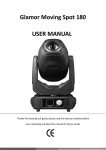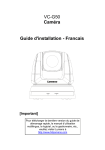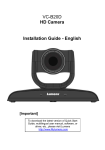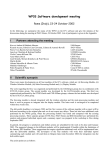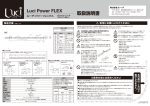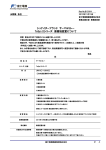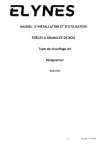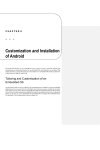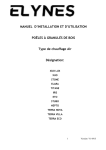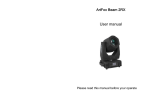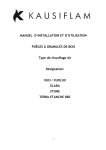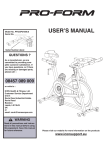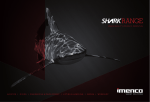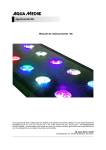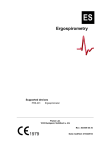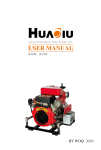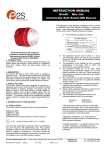Download 15W Class LED Module User Manual
Transcript
15W Class LED Module User Manual Model : LLDMWW0-15K902A Table of Contents 1 Product Description 1. ································ 1 2. Specification ································ 2 3. LED Module Instruction Manual ································ 10 4. Applications ································ 11 5. Warranty ································ 12 6. Ordering Information ································ 13 Appendix. A. Derived Models ································ 14 Appendix. B. LED Package Properties ································ 15 A Appendix. di C C. Th Thermall Management M t ································ 17 Appendix. D. Module applied with asymmetry Lens Instruction Guide ································ 21 1. Product Description The product is a LED module used for outdoor lights which is designed to endure in severe conditions such as, extremely high and low temperature, and highly humid condition, even to operate in the water. The LED Module also can be applied with 7 Variety-Lens depending on distribution type of light in the field of outdoor light application. Convertor (LED Driver) is required to operate the LED module and it should be satisfied with electrical and mechanical requirements for proper operation of the module. Before forcing to operate the LED modules with a convertor, LED module specifications such as, Forward Voltage and Current should be considered. Furthermore, how many LED modules are being used, what is total voltage, what is total current and how the modules are connected(series or parallel) should be considered to choose a proper convertor. Heat management of the LED module is very important since it determines the product life time. Therefore, an optimized heatsink attached to the module is one of the essential component for LED luminaires to ensure their proper operation. For more information, refer to Appendix. C. -1- 2. Specification Items Module Spec. Unit Specification Remarks Min Typ Max - 500 - Input Current mA DC Color Temperature K 6530 LED Q’TY EA 8 g Forward Voltage V 24 Total Luminous flux Lm 1000↑ Luminous efficiency lm/W 80 ↑ Storage Temperature ºC - 40 ~ 80 Operating Temperature ºC - 40 ~ 50 Weight g 92 ± 3% Connector not included Power Consumption (VDC) W 12 ± 10% CRI Ra 70 Size mm Φ76.5 11.9T Material - RoHS Compliance Halogen Free Life Time hr 50,000 ↑ Warranty up to 50,000 IP - IP67 Standards - EN 62031, 62471 UL 8750 ± 510 ± 10% CE, UL ◈ Models in the Appendix. A are measured to determine all values above with input current 500mA. ◈ All values above are measured by the Integrating Sphere of LG Innotek with EC1000S / WT210. ◈ All optic values are measured at 10± 2sec. in the Integrating Sphere. ◈ The Max. permitted input current putting into all models in the Appendix. A. is 650mA. ◈ CRI values can have tolerances in the range of 3% caused by Measuring Instruments. -2- ◆ Module Specification with Type III lens and 6500K CCT(Base Model) T Type III L Lens Horizontal view Vertical view ◆ Beam Angle : H 135 ° V 60° Light Distribution Table 1. Luminance values depending on Input Current If [mA] Luminance [lm] 500 1000 550 1055 600 1100 650(M 650(Max)) 1150 CCT[K] CRI 6500 72 All Values @ Tc = 65ºC * Values measured by KTR, 2011.5 * All values can have tolerances in the range of 5% caused by Measuring Instruments. KTR : Korea Testing & Research Institute (Public Approval Institution) -3- ◆ Module Specification with Type II lens and 6500K CCT T Type II L Lens Horizontal view Vertical view ◆ Beam Angle : H 160 ° V 70 ° Light Distribution Table 1. Luminance values depending on Input Current If [mA] Luminance [lm] 500 900 550 950 600 990 650(M 650(Max)) 1020 CCT[K] CRI 6500 72 All Values @ Tc = 65ºC * Values measured by KTR, 2011.5 * All values can have tolerances in the range of 5% caused by Measuring Instruments. KTR : Korea Testing & Research Institute (Public Approval Institution) -4- ◆ Module Specification with Type V(Sq130°) lens and 6500K CCT T Type V(Sq130°) V(S 130°) Lens L Horizontal view Vertical view ◆ Beam Angle : H 130 ° V 130 ° Light Distribution Table 1. Luminance values depending on Input Current If [mA] Luminance [lm] 500 1000 550 1055 600 1100 650(M 650(Max)) 1150 CCT[K] CRI 6500 72 All Values @ Tc = 65ºC * Values measured by KTR, 2011.5 * All values can have tolerances in the range of 5% caused by Measuring Instruments. KTR : Korea Testing & Research Institute (Public Approval Institution) -5- ◆ Module Specification with Type V(130°) lens and 6500K CCT T Type V(130°) Lens L Horizontal view Vertical view ◆ Beam Angle : H 130° V 130 ° Light Distribution Table 1. Luminance values depending on Input Current If [mA] Luminance [lm] 500 1000 550 1055 600 1100 650(M 650(Max)) 1150 CCT[K] CRI 6500 72 All Values @ Tc = 65ºC * Values measured by KTR, 2011.5 * All values can have tolerances in the range of 5% caused by Measuring Instruments. KTR : Korea Testing & Research Institute (Public Approval Institution) -6- ◆ Module Specification with Type V(115°) lens and 6500K CCT T Type V(115°) Lens L Horizontal view Vertical view ◆ Beam Angle : H 115° V 115 ° Light Distribution Table 1. Luminance values depending on Input Current If [mA] Luminance [lm] 500 1100 550 1180 600 1250 650(M 650(Max)) 1300 CCT[K] CRI 6500 72 All Values @ Tc = 65ºC * Values measured by KTR, 2011.5 * All values can have tolerances in the range of 5% caused by Measuring Instruments. KTR : Korea Testing & Research Institute (Public Approval Institution) -7- ◆ Module Specification with Type V(30°) lens and 6500K CCT T Type V(30°) Lens L Horizontal view Vertical view ◆ Beam Angle : H 30° V 30 ° Light Distribution Table 1. Luminance values depending on Input Current If [mA] Luminance [lm] 500 1100 550 1180 600 1250 650(M 650(Max)) 1300 CCT[K] CRI 6500 72 All Values @ Tc = 65ºC * Values measured by KTR, 2011.5 * All values can have tolerances in the range of 5% caused by Measuring Instruments. KTR : Korea Testing & Research Institute (Public Approval Institution) -8- ◆ Module Specification with Type V(20°) lens and 6500K CCT T Type V(20°) Lens L Horizontal view Vertical view ◆ Beam Angle : H 20° V 20 ° Light Distribution Table 1. Luminance values depending on Input Current If [mA] Luminance [lm] 500 1100 550 1180 600 1250 650(M 650(Max)) 1300 CCT[K] CRI 6500 72 All Values @ Tc = 65ºC * Values measured by KTR, 2011.5 * All values can have tolerances in the range of 5% caused by Measuring Instruments. KTR : Korea Testing & Research Institute (Public Approval Institution) -9- 3. LED Module Instruction Manual ◆ LED Module Installation ◈ When the LED module with Type II or III lens is mounted on a heatsink or luminaire, the connector way-out of the LED module should be oriented in a certain direction due to its asymmetric light distribution. Refer to the Appendix D. ◈ Combining the LED module with a heat-sink is very important for stable and normal operation of the LED module. There should be no gap between a thermal pad attached on the LED module plate, and the heatsink after they are assembled. Refer to Figure 8. in Appendix C. ◈ LED module should be tightly fixed on a heat-sink by fastening bolts. ◈ The connector(male) should be correctly linked with another connector(female) from a dedicated convertor. [ - : Black wire / + : Gray] ◆ Caution C i ◈ The LED module should not be operated by any unauthorized Power Supply Unit. The LED module must be used only with certain power supplies recommended by LG Innotek or a power which is satisfied for all the values in the Specification on Page 2. ◈ Heatsink which takes the thermal energy from the LED module should be tightly attached on the module so that the module temperature, especially at Tc, can keep the condition lower than 70 ˚C. ◈ A heat-sink combined with the LED module should not be directly mounted on the perfectly insulated ceiling or wall since it is hard to radiate the heat caused by the LED module. The heat from the LED module must disperse to the surroundings in order to keep the module temperature(Tc) under 70˚C. ◈ The LED module should be stored in the range of temperature between -40˚C 40 C and 80 80˚C. C. ◈ The connector or wires , coming from the module, should not be pulled by any forces. It causes that the LED module might not be properly operated. ◈ The LED module should not be struck by any physical impacts such as dropping the module into the ground. ◈ IP class of the module is IP67 which can protect against the affect of immersion under the water in depth only between 15cm ~ 1m for half an hour. ◈ Exceeding the operating current leads to an overload on the LED module. This may result in a significant reduction in product lifetime or even destruction of the LED module. The maximum permissible current is up to 650mA. ◈ Do not touch the LED module on purpose during the operation with a Power Supply - 10 - 4. Applications - 11 - 5. Warranty LG Innotek warrants the LED module for a period of five years from the date of sale to the buyer when properly installed on a Heatsink or Luminaire and under normal conditions of use. The buyer agrees to make all claims regarding defects or deficiencies in the LED module according to the terms of LG Innotek Innotek'ss official warranty warranty. Warranty claims should be made in writing according to LG Innotek procedures. Valid warranty claims must be made within the warranty period, 5 years, and submitted within seven days of discovery of the damage or defect. Field labor, repair, dismantle, or installation charges are NOT included with this warranty. Any unauthorized return, repair, replacement or modification of the Module shall void this warranty. This warranty does not cover any misapplication or misuse or installation in extremely hazardous or corrosive environments. Contact LG Innotek (82-31-000-000/ @lginnotek.com) for complete warranty language, exceptions, limitations, more details. - 12 - 6. Ordering Information Item Option Code 3000K WW 4000K NW 6500K CW Type II (H:135ºC V:60ºC) A Type III (H:135ºC V:60ºC) B Type V (Square 130ºC) C Type V (Circle 130ºC) D Type V (Circle 115 115ºC) C) E Type V (Circle 30ºC) F Type V (Circle 20ºC) G CCT Lens Connector JWPF, waterproof Connector JST Mfg. Co, Ltd. U No connector - N 100mm each Cable Length 200mm each 10 LS cable. Co, Ltd. 20 400mm each 40 Ex) LED Module with Type III lens, Connector, 100mm cable, 6500K PKG Product Name CCT Lens Connector Cable Length Eagle eye CW B U 10 Eagle eye-CW-B-U-10 *Red Red Color : Not available (Developing now in progress) - 13 - Appendix. A. Model Information 1. Model Name CCT Lens Model Name Type II LLDMWW0-15K901A Type III LRD01-11J4A (LLDMWW0-15K902A) Type V(Sq 130°) LLDMWW0-15K903A Type V(130°) LLDMWW0-15K904A Type V(115°) LLDMWW0-15K905A Type V(30°) LLDMWW0-15K906A Type V(20°) LLDMWW0-15K907A 6500K 2. Model Dimension - 14 - Remarks Base Model Appendix. B. LED Package Properties 1. LED PKG Flux Characteristics ((tj= 25ºC)) CCT Range Color Cool White Min Max 5000K 8300K Luminous Flux [lm] @ 350mA Typical CRI 122 75 2. LED PKG Characteristics Characteristics Unit Typical Maximum Thermal Resistance(Junction to Solder Point) ºC/W 6 75 Viewing Angle Degrees 125 Temperature Coefficient of voltage mV/ºC -2.1 ESD Classification (HBM per Mil-Std-883D) - Class 2 DC Forward Current mA - 1500 Reverse Voltage V - 5 Forward Voltage @ 350mA V 3.0 3.75 Forward Voltage @ 700mA V 3.2 Forward Voltage @ 1000mA V 3.3 LED Junction Temperature ºC - 150 3. LED PKG Characteristic Curve Figure 1. Relative Luminous Flux vs. Current Figure 2. Electrical Characteristics (Tj = 25 ºC) - 15 - 4. PKG Multi-Rank Mixing(M.R.M) • CCT = 6530K ± 510K To keep the value of CCT of the LED Module in the specified range, the PKG Rank enclosed with red line in the Figure 9 should be mixed as shown in the Table2. Arrangement of the LED PKG on the Metal PCB is recommended as shown Figure 10. Figure.3 Chromaticity Region for ANSI Cool White Table1. The Order of Priority for PKG M.R.M PKG M.R.M P1 P1 P1 P1 P2 P2 P2 P2 P2 P2 PKG A 1A 1B 1B 1A 1S 1T 1B 1A 1C 1D PKG B 1D 1C 1D 1C 1U 1R 1U 1T 1R 1S P1 : The First Order of Priority for PKG M.R.M P2 : The Second Order of Priority for PKG M.R.M Figure.4 PKG Arrangement - 16 - Appendix. C. Thermal Management 1. Overview • Since heat-sink design for the module would affect lifetime and performance of the module, a heat-sink or luminaire should be designed with thermal considerations to smoothly dissipate the thermal energy to the ambient. • End product with the LED module should be designed in a manner which minimizes the thermal resistance from the solder point to ambient in order to optimize the LED module life and its optical characteristics 2. Heat sink Design guide • The lifetime of the LED module cannot be guaranteed if operated without a heat-sink. The heat-sink should be coupled with the module for thermal management as shown in Figure 9. • Design of the heat-sink is one of the main factor which determines lifetime and performance of the module. Hest-sink should be designed to keep the module temperature, Tc, under 70°C. • Recommended material for the heat-sink is metals such as,, Aluminum whose conductivityy is relatively higher and cheaper than other materials. In addition, surface treatment of the heat-sink is important to increase the rate of heat-transfer. Powder coating and Anodizing might be a good solution for the surface treatment of the heat-sink. Figure.5 Assembly between Heat-sink(Al) and LED Module - 17 - 3. Case Temperature & Junction Temperature • Junction Temperature(Tj) Definition of Junction Temperature(Tj) is internal temperature of a chip at which temperature has the highest value. Since it is hard to measure Junction Temperature(Tj) at firsthand, firsthand the value of the Tj can be assumed by the equation shown in Figure.11 on the next page. • Case Temperature (Tc): Case Temperature(Tc) is the temperature at the center point of the module plate remarked in Figure 10. It shows how to measure Tc. *Case Temperature(Tc) should be lower than 70ºC while the LED module is operating. Thermal paste Case temperature (Tc) Thermocouple Figure.6 Module Plate (bottom view) - 18 - 4 Estimation of Junction Temperature (Tj) 4. • Junction temperature (Tj) could be estimated by the equation below in Figure 11. • Tc point can be measured as described in Figure 10. Fixture or Heat sink Tc Thermal Pad Rjc (Tj ~ Tc) Tj Tj = Tc + Ptotal x Rjc Figure8. Temperature of the Module at each position • How to obtain the value of Tj when Tc is measured at 50℃ ※ Basic Equation → Tj = Tc + Ptotal x Rjc - Ptotal = Typical Input Current x Forward Voltage = 0.5[A] 0 5[A] x 24.0[V] 24 0[V] = 12.0[W] 12 0[W] - Rjc = 1.6 [℃/W] → The value of Thermal Resistance is obtained by LGIT internal experiment Æ ex) Tj = Tc + Rjc x Ptotal = 50[℃] + 1.6[℃ /W] x 12[W] = 69.2[℃] - 19 - 5 PKG Property depending on Junction Temperature (Tj) 5. Current Ta(℃) Tsp(℃) Tj(℃) L70(hours) 350mA 85 85 91 174,071 1000mA 85 85 105 74,773 ※Reliability test result of PKG Fi Figure 9. 9 Luminous L i Flux Fl VS. VS Time Ti ※Current at 350mA Fi Figure10. 10 Relative R l ti Fl Flux VS. VS Junction J ti Temp. T LED Module Thermal Specifications Parameter Min Min. T pical Typical Ma Max. Unit Tj 90 105 ℃ Tc 70 ℃ Rjc 1.6 ℃/W L70 50,000 Hours - 20 - Remarks Appendix. D. Module with Asymmetry Lens Instruction Guide Si Since type t II andd type t III lens l have h their th i own light li ht distribution di t ib ti direction, di ti the th LED module d l with a type II or III lens has asymmetry light distribution unlike other lenses. Therefore, intended light distribution should be considered before attaching the LED module on a heatsink or luminaire. As shown below Figure 14, the LED module with type III lens should be mounted correctly in the right direction on the luminaire in order to obtain suitable light distribution on the roadway. <Ο> <X> Figure.7 Light distribution on the road surface depending on the LED Module direction *Simulation image of street light applied by LED modules with Type III lens - 21 -























